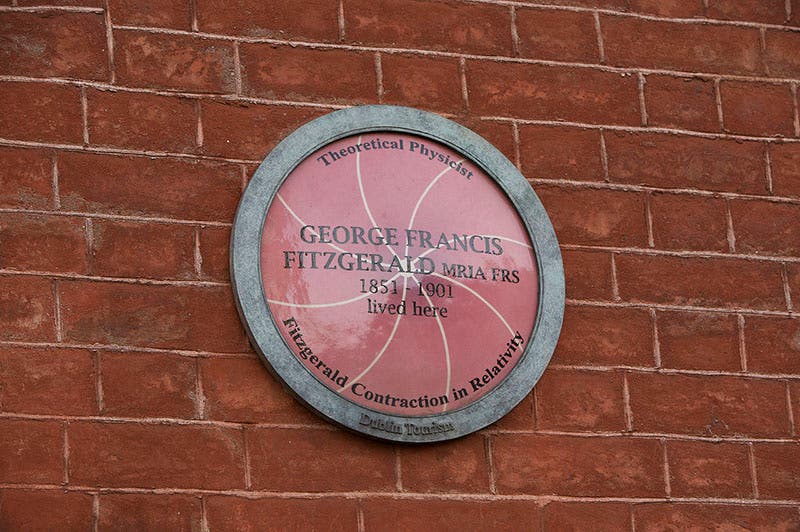Scientist of the Day - George Francis FitzGerald
George Francis FitzGerald, an Irish physicist, was born Aug. 3, 1851. Fitzgerald was one of a small group of physicists who have been called "The Maxwellians," because they strove to further the work in electromagnetism of James Clerk Maxwell, who published his milestone book, A Treatise on Electricity and Magnetism, in 1873. In 1883, FitzGerald proposed a way to generate electromagnetic waves by producing rapid oscillations in an electric current. FitzGerald did not make such a device, but five years later Heinrich Hertz did just that, and the radio-wave era began. Hertz was another Maxwellian, about whom we have already written a post, as we have for Oliver Heaviside; we have not yet done Oliver Lodge.
FitzGerald is best remembered today for a single letter that he wrote to the journal Science in 1889. Two Americans, Albert Michelson and Edward Morley, had done an experiment in 1887, in which they tried to measure the speed of the earth through the "ether" that everyone was sure existed to carry electromagnetic waves. The Michelson-Morley experiment could detect no ether drift at all, suggesting that either the earth was at rest in the ether, which seemed unlikely, or there was no ether, which was even more unlikely. So physicists had a conundrum. We have written posts on both Michelson and Morley; the one on Morley contains a discussion of their famous experiment.
In his letter to Science, which was quite brief, FitzGerald proposed that the best way to explain the null result of the Michelson-Morley experiment was to assume that the length of an object was not a constant, but that objects moving through the ether with a velocity v were contracted by a factor of v2/c2, where c is the speed of light. Several years later, Hendrik Lorentz independently made the same suggestion, and the proposed shortening came to be called the FitzGerald-Lorentz contraction (or the Lorentz-FitzGerald contraction). It remained esoteric until Albert Einstein wrote his paper on special relativity in 1905, in which he argued that for objects moving relative to any reference frame, distance is shortened and time slows down, and the adjustment factor is the FitzGerald-Lorentz equation
The story of FitzGerald and his letter has been often told, but I have only seen the letter reproduced once, and that was in a work of academic scholarship. So for this occasion we pulled out volume 13 of the journal Science and had the page scanned. We show you the two-page spread where the letter is embedded (second image), and then a detail showing just the letter (third image).
As an interesting sidelight, when Lorentz in 1894 discovered that FitzGerald had anticipated him, he wrote FitzGerald and asked if he had published anything on the subject. FitzGerald replied that he had sent off a letter to Science several years earlier, but he didn’t know if it was ever published, and therefore Lorentz should get all the credit. So the transformation was almost called the “Lorentz contraction.” Fortunately for FitzGerald, even if he was not aware of it, his letter did find its way into print, and his priority was established.
FitzGerald taught physics at Trinity College, Dublin, and was troubled with stomach problems his entire life. He died of complications from an ulcer in 1901, at the age of 49. Colleagues mourned his loss and immediately published a volume containing all his papers, The Scientific Writings of the Late George Francis Fitzgerald (1902). It contains a fine frontispiece photographic portrait of FitzGerald that we include here (first image).
FitzGerald is buried in Mount Jerome cemetery in Dublin. I could not find a photo of his grave, but there is a memorial plaque outside the house in Dublin where he lived out a life cut much too short (fourth image).
Dr. William B. Ashworth, Jr., Consultant for the History of Science, Linda Hall Library and Associate Professor emeritus, Department of History, University of Missouri-Kansas City. Comments or corrections are welcome; please direct to ashworthw@umkc.edu.









